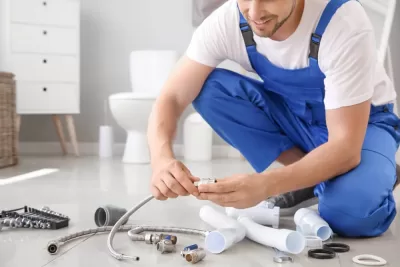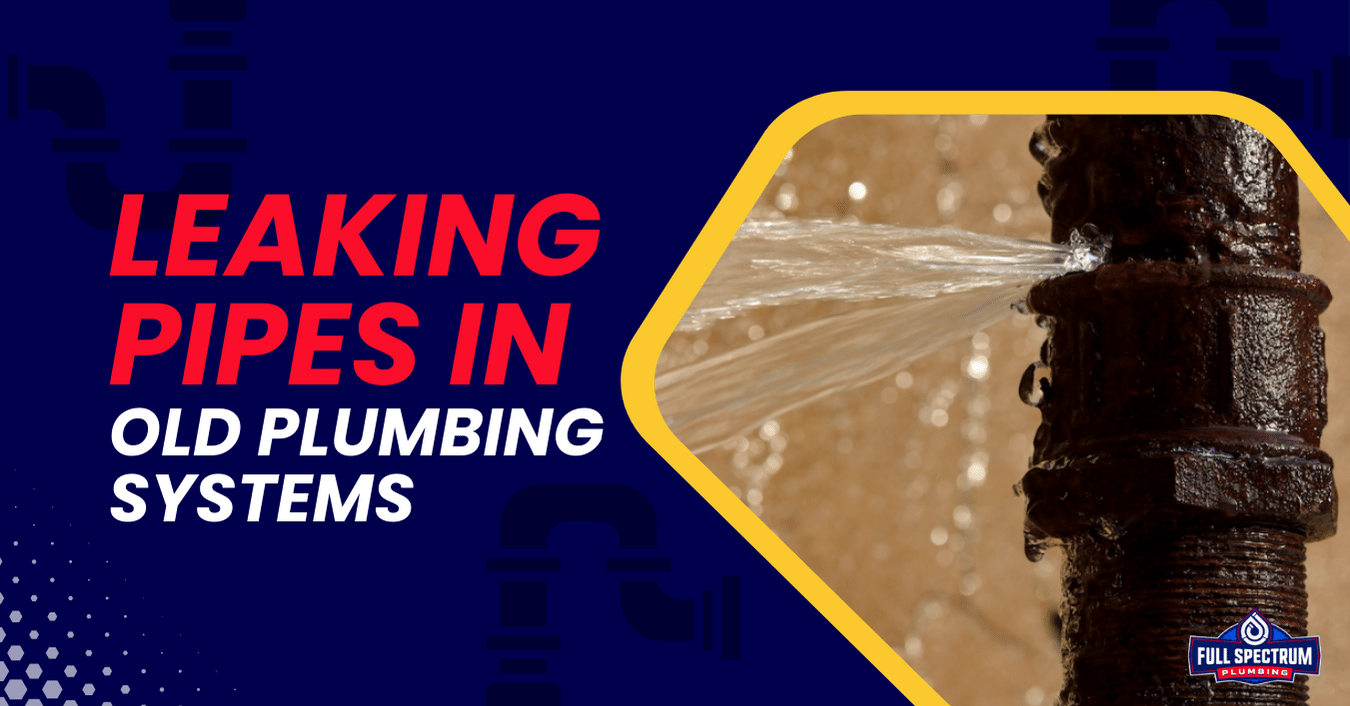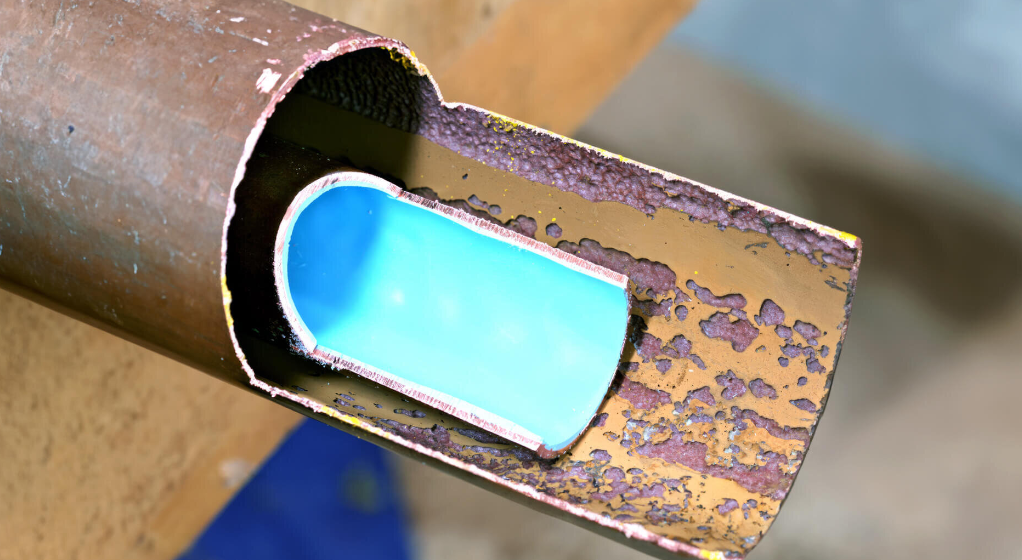If you live in an older home or occupy an older building that was built more than 50 years ago, you may have aging water lines that require rapid replacement. This is especially the case if the property was erected before the advent of indoor plumbing.
Because of this, it is essential to keep a watchful eye (or ear) out for indicators of concealed pipe leaks, such as stains on your walls or ceiling or sudden spikes in your water bill for Rock Hill or adjacent places like Fort Mill.

Whole Home Repiping Service For Your Convenience
At Full Spectrum Plumbing Services, we specialize in providing top-notch whole home repiping services. If you’re experiencing frequent leaks, low water pressure, or outdated plumbing systems, it may be time to consider repiping your house. Our team of experts is well-equipped to handle all aspects of repiping, ensuring that your home’s plumbing system is efficient, reliable, and up to code.
When it comes to the cost of repiping a house, it can vary depending on several factors, such as the size of your home, the complexity of the plumbing system, and the type of materials used. At Full Spectrum Plumbing Services, we offer competitive pricing tailored to your specific needs. Our goal is to provide you with a cost-effective solution that meets your budget while delivering exceptional results.
As repiping specialists, we take pride in delivering high-quality service and ensuring customer satisfaction. Our team is composed of skilled professionals who have undergone rigorous training and have extensive knowledge in the field of repiping. We stay up to date with the latest industry practices and utilize advanced tools and technologies to provide you with the best possible results.
Don’t let outdated plumbing systems or recurring leaks disrupt your daily life. Invest in whole home repiping and enjoy the benefits of a reliable and efficient plumbing system for years to come.
Common Causes of Broken Pipes
Broken pipes can cause significant damage to your property and disrupt your daily life. Understanding the causes of broken pipes can help you take preventive measures and minimize the risk of plumbing emergencies.
Here are some common factors that can lead to pipe breakages:
- Freezing Temperatures: During cold winter months, water inside pipes can freeze and expand, putting pressure on the pipe walls. This increased pressure can cause pipes to crack or burst. Frozen pipes are particularly common in uninsulated or poorly insulated areas of the home, such as attics, basements, or exterior walls.
- Corrosion: Over time, pipes can corrode due to chemical reactions with water or soil. Corrosion weakens the pipe material, making it more susceptible to cracks, leaks, and eventual breakage. Factors such as high mineral content in water, improper pH levels, or exposure to aggressive chemicals can accelerate the corrosion process.
- Water Pressure Issues: Excessive water pressure can strain pipes, leading to fractures or ruptures. This can occur when the water pressure regulator is not functioning correctly or when there are sudden pressure spikes in the water supply. In contrast, water hammer—a phenomenon caused by the sudden stoppage or change in water flow—can also create stress on pipes, resulting in damage over time.
- Age and Wear: Pipes have a finite lifespan, and as they age, they become more prone to deterioration and breakage. Older homes may have pipes made from outdated materials like galvanized steel or cast iron, which are more susceptible to corrosion and damage compared to modern materials like copper or PVC.
- Tree Root Intrusion: Tree roots seeking water and nutrients can infiltrate underground pipes, causing blockages, cracks, or even complete pipe collapse. This is especially common in older sewer lines made of clay or concrete.
- Improper Installation or DIY Repairs: Poorly installed or repaired pipes can be prone to leaks and breakages. If pipes are not properly aligned, supported, or secured, they may experience excessive stress and fail prematurely.
- Ground Shifting or Settling: Natural ground movements, such as shifting soil or settling foundations, can put stress on pipes. This stress can cause pipes to shift, bend, or break, leading to leaks or bursts.
Understanding the potential causes of broken pipes can help you take proactive steps to prevent plumbing issues. Regular inspections, proper insulation, maintaining consistent water pressure, and seeking professional assistance for installation and repairs are essential to safeguarding your plumbing system and avoiding costly damages. If you suspect a broken pipe in your home, it’s crucial to contact a qualified plumber to assess the situation and provide the necessary repairs.
Types of Pipes
At Full Spectrum Plumbing Services, we offer a variety of repiping options to meet the unique needs of our customers. Whether you’re experiencing leaks, low water pressure, or outdated plumbing systems, we have the expertise to provide the right repiping solution for you. Here are some of the types of repiping services we specialize in:
Galvanized Pipes
Issues with Galvanized Pipes
Galvanized pipes were once a popular choice for plumbing systems in residential and commercial buildings. However, they are now known to present several issues:
Corrosion and Rust: Galvanized pipes are made of steel coated with a layer of zinc to prevent corrosion. Over time, the protective zinc coating can deteriorate, exposing the underlying steel to moisture. This leads to corrosion and rust formation on the interior and exterior surfaces of the pipe. Corroded pipes can restrict water flow, develop leaks, and eventually require replacement.
Reduced Water Flow: As galvanized pipes corrode and rust, the buildup of sediment and scale inside the pipes can cause reduced water flow. The accumulation of mineral deposits narrows the diameter of the pipes, limiting the amount of water that can pass through. This can result in low water pressure and inefficient water supply to fixtures and appliances.
Water Quality Concerns: Corroded galvanized pipes can affect the quality of your tap water. Rust particles and other contaminants may flake off from the pipes, causing discoloration, foul odors, and an unpleasant taste in the water. Additionally, the presence of rust can indicate that the pipes are deteriorating and may be prone to leaks or bursts.
Leakage and Water Damage: As galvanized pipes age and corrode, they become more susceptible to developing leaks. These leaks can lead to water damage in your walls, ceilings, or floors, potentially causing mold growth and structural issues. Identifying and repairing leaks in galvanized pipes can be challenging, as the corrosion may cause multiple weak points along the pipe.
Advantages and Disadvantages of Galvanized Pipes
Advantages
Initial Cost: Galvanized pipes tend to be less expensive compared to some alternative materials, making them a cost-effective option for initial plumbing installations.
Durability: Galvanized pipes can last for several decades under ideal conditions. They are relatively resistant to impact damage and can withstand high water pressure.
However, it’s important to consider the disadvantages of galvanized pipes:
Disadvantages
Limited Lifespan: Galvanized pipes have a limited lifespan due to their susceptibility to corrosion and rust. Over time, they will likely require replacement or extensive repairs.
Reduced Water Flow: Galvanized pipes can experience reduced water flow due to the accumulation of sediment and rust within the pipes.
Water Quality Concerns: The presence of rust and contaminants in galvanized pipes can affect the quality of the tap water, leading to discoloration, odors, and an unpleasant taste.
Maintenance and Repairs: Maintaining galvanized pipes can be challenging. Regular inspections and repairs are necessary to address corrosion, leaks, and other issues that may arise.
Polybutylene Pipes
Issues with Polybutylene Pipes
- Propensity to fail and break
- Don’t last as long as copper and PVC
- Difficult to work with as they require specialized tools and techniques
Advantages and Disadvantages of Polybutylene Pipes
Advantages
- Lightweight
- Flexible
- Low Cost
- Durable
Disadvantages
- Temperature Sensitivity
- Not suited for outdoor use
- Difficult installation
Dura PEX
Common Issues with Dura PEX Pipes
Fittings Compatibility: Dura PEX pipes may require specific fittings designed for compatibility with the PEX system. Using incompatible fittings or mixing different brands of fittings can lead to leaks or connections that are not secure.
UV Resistance: PEX pipes, including Dura PEX, are not UV resistant. If exposed to direct sunlight or outdoor elements, the pipes can deteriorate over time. It’s crucial to protect exposed PEX pipes with appropriate insulation or covering when installed outdoors.
Freezing Temperatures: Although PEX pipes are generally more resistant to freezing than some other materials, extreme cold temperatures can still cause them to expand and potentially develop cracks. Adequate insulation and protection against freezing conditions are necessary to prevent damage.
Installation Errors: Improper installation techniques, such as kinking, crushing, or improper expansion fittings, can lead to issues with Dura PEX pipes. These errors may compromise the integrity of the system, resulting in leaks or reduced water flow.
Chemical Incompatibility: PEX pipes, including Dura PEX, may be incompatible with certain chemicals or substances commonly found in the water supply, such as acidic water or highly chlorinated water. Chemical reactions can cause deterioration of the pipes or affect their performance over time.
Advantages and Disadvantages of Dura PEX Pipes
Advantages
- Flexibility and Ease of Installation
- Resistance to Corrosion and Scale
- Freeze Resistance
- Reduced Noise Transmission
Disadvantages
- UV Sensitivity
- Potential Fittings Compatibility Issues
- Chemical Compatibility Concerns
- Installation Errors
HDPE Piping
Common Issues with HDPE Piping
- Temperature Limitations: HDPE pipes have a temperature limitation compared to other materials. They have a lower temperature resistance, and prolonged exposure to high temperatures can cause the pipes to deform or even melt.
- Joint Integrity: Achieving proper joint integrity during installation is crucial for HDPE piping. The joints must be carefully fused or mechanically connected to ensure a secure and leak-free system. Improper joint connections can lead to leaks or pipe failure.
- UV Degradation: HDPE pipes are susceptible to UV degradation when exposed to direct sunlight for extended periods. This can result in a reduction in the pipe’s lifespan and structural integrity. Therefore, it’s important to protect exposed HDPE pipes with UV-resistant coatings or proper insulation.
- Chemical Compatibility: While HDPE is generally resistant to many chemicals, certain aggressive chemicals or substances may have a detrimental effect on the pipe material. It’s important to consider the specific chemical compatibility requirements of HDPE when selecting it for a particular application.
Advantages and Disadvantages of HDPE Piping
Advantages
- High Flexibility
- Chemical Resistance
- Long Lifespan
- Leak-Free Joints
- Smooth Interior Surface
Disadvantages
- Temperature Limitations
- UV Degradation
- Cost Considerations
- Limited Size Availability
CPVC Piping
Common Issues with CPVC Piping
- Temperature and Pressure Limitations: CPVC pipes have specific temperature and pressure limitations. Exceeding these limits can cause the pipes to deform, weaken, or even rupture. It’s crucial to follow manufacturer guidelines and adhere to local building codes to ensure the safe operation of CPVC piping systems.
- Chemical Compatibility: While CPVC pipes generally have good chemical resistance, certain aggressive chemicals or solvents may cause degradation or failure of the piping material. It’s important to verify the chemical compatibility of CPVC with the intended application and consult the manufacturer’s recommendations.
- Expansion and Contraction: CPVC pipes have a higher coefficient of thermal expansion compared to other materials. Changes in temperature can result in expansion and contraction of the pipes, potentially causing stress on the joints and connections. Proper allowance for expansion and contraction should be made during installation to prevent issues.
- Solvent Cement Application: CPVC pipes require the use of solvent cement for joining. Improper application of solvent cement, such as insufficient curing time or incorrect application technique, can lead to weak or faulty connections, resulting in leaks or pipe failure.
Advantages and Disadvantages of CPVC Piping
Advantages
- Corrosion Resistance
- Easy Installation
- Affordability
- Smooth Interior Surface
Disadvantages
- Temperature and Pressure Limitations
- Expansion and Contraction
- Chemical Compatibility
Copper Piping
Common Issues with Copper Piping
- Corrosion: Copper piping is generally corrosion-resistant, but in certain conditions, such as highly acidic or aggressive water, corrosion can occur. Corrosion may lead to leaks or pinhole-sized openings in the pipes over time.
- Price Volatility: Copper prices can be volatile, which can impact the cost of materials for copper piping projects. Fluctuations in copper prices can make it challenging to estimate or budget for plumbing installations or repairs.
- Water Quality: Copper pipes can release small amounts of copper into the water supply, particularly in the initial stages of installation. While copper is generally considered safe, excessive copper levels in drinking water may have health implications for sensitive individuals.
- Susceptibility to Freeze Damage: Copper pipes are susceptible to freezing and can burst if not adequately protected in freezing temperatures. Proper insulation and precautions must be taken in areas prone to freezing to prevent damage.
Advantages and Disadvantages of Copper Piping
Advantages
- Durability
- Corrosion Resistance
- Heat Resistance
- Proven Track Record
Disadvantages
- Initial Cost
- Installation Complexity
- Water Quality Concerns
- Noise Transmission
Pex Piping
Common Issues with PEX Piping
- UV Degradation: PEX piping is susceptible to degradation when exposed to direct sunlight or UV radiation for extended periods. It is important to protect PEX pipes from UV exposure during installation and consider using UV-resistant coatings or insulation when necessary.
- Fittings and Connections: Proper installation of fittings and connections is crucial for PEX piping systems. Improper installation techniques, such as inadequate crimping or incorrect expansion ring placement, can result in leaks or failure at the joints.
- Freeze Damage: While PEX pipes are more resistant to freeze damage compared to rigid materials like copper, they can still burst if water freezes inside the pipes. Proper insulation and precautions should be taken in areas prone to freezing temperatures to minimize the risk of damage.
- Chemical Compatibility: PEX pipes are generally resistant to many common chemicals. However, certain chemicals, solvents, or substances can have a detrimental effect on the pipes, leading to degradation or failure. It is important to consider the specific chemical compatibility requirements of PEX when selecting it for a particular application.
Advantages and Disadvantages of PEX Piping
Let’s explore the advantages and disadvantages of PEX piping:
Advantages
- Flexibility and Ease of Installation
- Corrosion Resistance
- Freeze Resistance
- Quiet Operation
Disadvantages
- UV Degradation
- Temperature and Pressure Limitations
- Chemical Compatibility
- Long-Term Durability
Pricing
The cost of repiping in South Carolina can vary greatly, depending on the size of the home, type of pipe material being used, and other factors. Generally speaking, prices for copper repiping range from $2.50-3 per linear foot; PEX (cross-linked polyethylene) piping ranges from $1-2 per linear foot; and CPVC (chlorinated polyvinyl chloride) runs anywhere from $1.50-$8 per linear foot. There may also be additional costs involved for permits or extra services you didn’t anticipate initially—so making sure to get an accurate estimate before making a final decision is key!
To get an accurate pricing estimate for repiping your house, it is recommended to contact us here Full Spectrum Plumbing Services near you. We will assess your specific requirements and provide you with a detailed breakdown of the costs involved in the repiping project.
Contact us today for an estimate!



